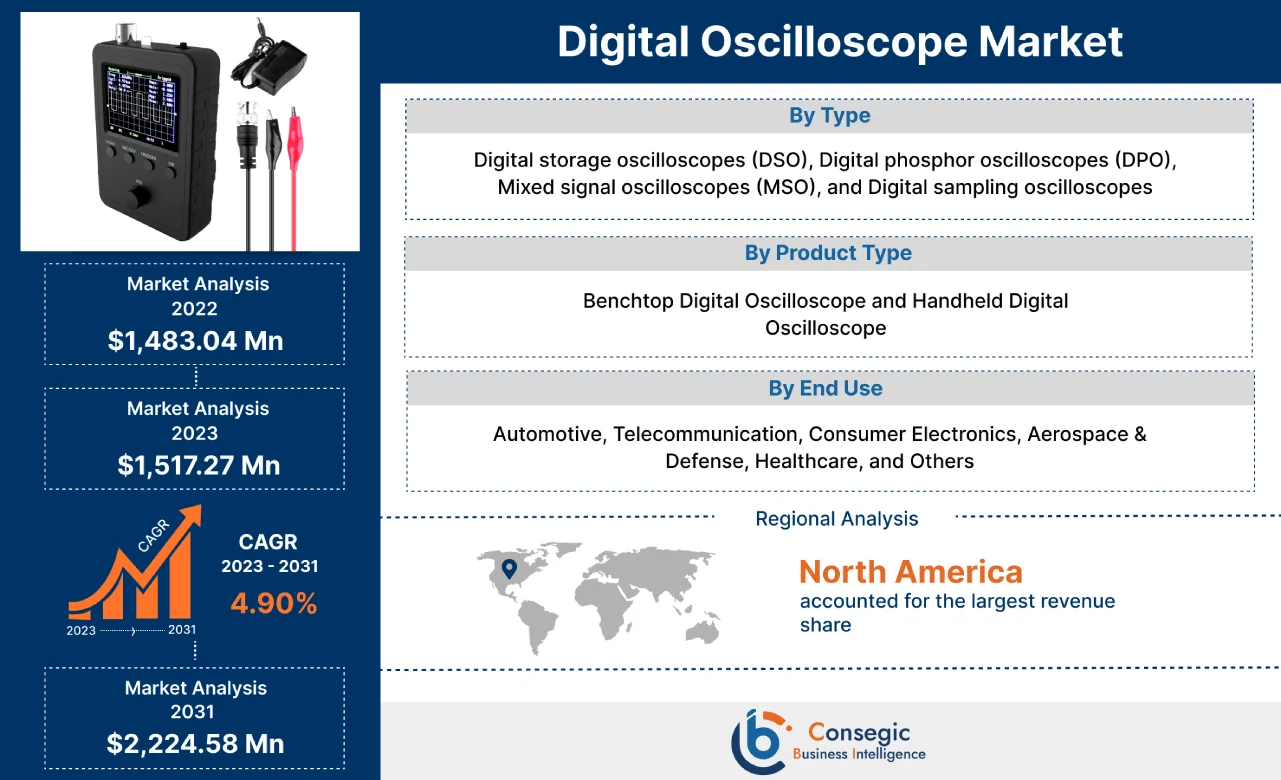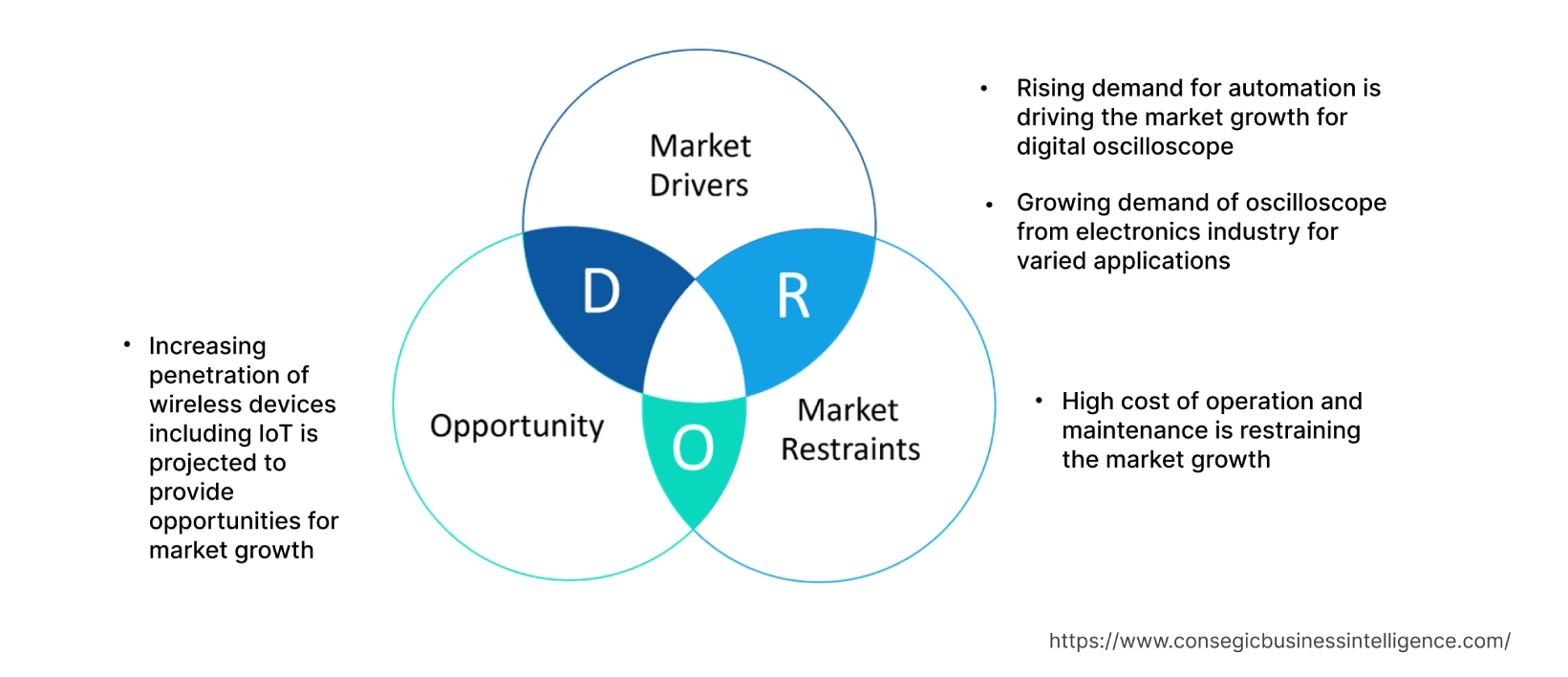- Summary
- Table Of Content
- Methodology
Digital Oscilloscope Market Size :
Digital Oscilloscope Market size is estimated to reach over USD 2,224.58 Million by 2031 from a value of USD 1,483.04 Million in 2022 and is projected to grow by USD 1,517.27 Million in 2023, growing at a CAGR of 4.90% from 2023 to 2031.
Digital Oscilloscope Market Scope & Overview:
Digital Oscilloscope is an electronic device that measures and records electronic signals transmitted in the form of analog signals. In another terms, digital oscilloscope transforms analog signals into digital format and stores it in the digital memory format for further analysis. Key applications of digital oscilloscope include electronic troubleshooting, medical analysis, industrial testing, communication engineering, among others. Moreover, the instruments have wide acceptance in the field of healthcare to measure and analyze electrical signals from the human body, such as heartbeats and brainwaves. Among similar functions, digital oscilloscope has applications in telecommunication sector for testing and analyzing communication signals emitted by cell phones and computers.
Digital Oscilloscope Market Insights :
Key Drivers :
Rising demand for automation is driving the market growth for digital oscilloscope
Automation is defined as a process or application of technology to deliver goods and services without human or minimal intervention. The key attributing factors towards the adoption of automation in current scenarios is due to the rising demand for reliability, efficiency, and speed to perform any task. In a general approach robotic process automation (RPA) is gaining popularity among industries to fasten the production process in parallel to maintaining the efficiency. In context to the aforementioned information digital oscilloscopes are playing an important role in fulfilling the requirements of automation.
In addition, one of the types include digital storage oscilloscopes (DSO) is widely in use for automation processes. DSOs are more versatile and accurate than analog oscilloscopes, and they are becoming increasingly popular in automation applications. In automation, DSOs are used to troubleshoot and diagnose problems in electronic systems. DSOs are used to monitor and control systems, and to perform research and development activities during the production process.
For instance, Aplab Global has launched DSO Series of oscilloscope that operates at 70 MHz to 200 MHz having 2 channels. The flagship products include D37200A, D37100A, and D37070A that features 32 automatic measurement and track measurements. The key applications of DSO series include electronic circuit designing, manufacturing testing and quality control which are mainly employed for automation practices.
Growing demand of oscilloscope from electronics industry for varied applications
The demand for oscilloscopes from the electronics industry is growing due to the increasing complexity of electronic devices and systems. Moreover, with increasing sophistication of electronic devices, the demand for digital oscilloscopes is fueling owing to growing requirement for accurate and versatile measuring devices. Also, the increasing application of embedded systems within varied consumer electronics including smartphones, HMIs (Human Machine Interface ) in cars coupled with healthcare devices is proliferating the market growth of digital oscilloscope market. Furthermore, with the growing requirements of engineering machines in various sectors including telecommunication, scientific research, aerospace, among others for functions such as test circuitry, troubleshooting, monitoring, and debugging of systems is driving the market growth for digital oscilloscopes.
Key Restraints :
High cost of operation and maintenance is restraining the market growth
Digital oscilloscope has a very high cost that depends on factors including features, brand, and specifications. On average the cost of a Digital oscilloscope ranges from USD 500 to maximum of USD 10,000. In addition, the cost of maintenance and expenditure incurred for its operation tends to be high. Moreover, factors including bandwidth, sampling rate, resolution, number of channels tend to influence the pricing of the instruments. For instance, bandwidth is the range of frequencies that an oscilloscope measures. A wider bandwidth is required for measuring higher-frequency signals, which increases the pricing of the devices. Furthermore, factors such as sampling rate which is the number of times per second that the oscilloscope captures the signal. A higher sampling rate is required for measuring faster signals that ultimately increases the pricing of the final product. Therefore, owing to the specifications and aforementioned features of the device which tends to be high is hindering the market growth of digital oscilloscope.
Future Opportunities :
Increasing penetration of wireless devices including IoT is projected to provide opportunities for market growth
Increasing application of wireless devices including smartphones, smart devices, home equipment are rapidly gaining popularity among consumers. Thus, advent of technology including introduction of IoT (Internet of Things) is further promoting the market growth of the wireless devices. The key function of digital oscilloscope is to test and debug IoT devices including sensors and actuators.
Moreover, IoT devices are often equipped with sensors that generate electrical signals. Electrical signals are used to monitor the health of the device, detect errors, and collect data. Digital oscilloscopes are therefore used to visualize and analyze electrical signals. Accordingly, the received information is used to identify issues with the device including working of faulty sensor or a malfunctioning of circuit. Therefore, owing to the rising applications of wireless devices among consumers and rise in trend for IoT devices is projected to provide opportunities for the market of digital oscilloscope to grow.
Digital Oscilloscope Market Report Insights :
| Report Attributes | Report Details |
| Study Timeline | 2017-2031 |
| Market Size in 2031 | USD 2,224.58 Million |
| CAGR (2023-2031) | 4.90% |
| By Type | Digital storage oscilloscopes (DSO), Digital phosphor oscilloscopes (DPO), Mixed signal oscilloscopes (MSO), and Digital sampling oscilloscopes |
| By Product Type | Benchtop Digital Oscilloscope and Handheld Digital Oscilloscope |
| By End Use | Automotive, Telecommunication, Consumer Electronics, Aerospace & Defense, Healthcare, and Others |
| By Region | North America, Europe, Asia-Pacific, Latin America, and Middle East & Africa |
| Key Players | OWON Technology Inc., Good Will Instrument Co., Ltd., Fluke Corporation, Siglent Technologies, Keysight Technologies, Rohde & Schwarz GmbH & Co KG, Pico Technologies, Yokogawa Electric Corporation, General Polytronic Systems Ltd., Tektronix Inc., Teledyne LeCroy, Olimex, B&K Precision, Agilent Technologies Inc. |
Digital Oscilloscope Market Segmental Analysis :
By Type :
Based on the type, the market is bifurcated into digital storage oscilloscopes (DSO), digital phosphor oscilloscopes (DPO), mixed signal oscilloscopes (MSO), and digital sampling oscilloscopes. Digital storage oscilloscopes (DSO) is accounted to generate largest market share in the year 2022. DSOs are relatively inexpensive and easy to handle and are employed in general-purpose applications. DSOs functions by storing the waveform of an electrical signal in digital form. Thus, allowing the waveform to be displayed on the oscilloscope's screen, which is later saved to a computer for analyzing it offline.
The Digital phosphor oscilloscope (DPO) segment is anticipated to grow at the fastest growth rate during the forecast period. DPOs are a type of oscilloscope that offer advantages over DSOs. DPOs have features of displaying waveforms with a higher refresh rate, making them better suited for capturing fast-changing signals. In addition, with the growing requirement for more advanced digital oscilloscope in industries, DPOs are increasingly gaining popularity due to additional features such as ability to have a longer record length, which allows them to capture longer waveforms. Thus, owing to aforementioned features DPOs are projected to drive the market growth during the forecast period.
By Product Type :
Based on the product type, the market is segmented into benchtop digital oscilloscope and handheld digital oscilloscope. The benchtop digital oscilloscopes segment is accounted to generate largest market share in the year 2022. Benchtop digital oscilloscopes are more popular owing to more features and capabilities offered by it including higher bandwidth, sample rate, and record length. Since benchtop digital oscilloscopes devices are typically have more advanced features, such as digital triggering, waveform analysis, and compliance testing, they are more in demand among sectors including telecommunication, healthcare, among others tends to be driving their market growth.
On the other hand, handheld oscilloscopes are smaller and more portable than benchtop oscilloscopes, the segment is projected to grow at the fastest growth rate during the forecast period. Handheld oscilloscopes are a good option for field work or troubleshooting problems in remote locations. However, handheld oscilloscopes typically have lower bandwidth, sample rate, and record length than benchtop oscilloscopes. Moreover, with the growing requirements for easy-to-use tools at the point of application will promote market growth for the segment in overall digital oscilloscope market.
By End-User :
Based on the end use, the market is segmented into automotive, telecommunication, consumer electronics, aerospace & defense, healthcare, and others. The telecommunications segment accounted for the largest market share of 31.4% in 2022. The key factors driving the growth of this segment are the rising demand for improved telecommunications infrastructure and enhanced network connectivity. Additionally, the segment is expected to grow at the fastest rate during the forecast period. This is due to the increasing adoption of 5G connectivity worldwide and the need for robust telecommunications infrastructure in a variety of industries, such as healthcare and automotive.
In addition, the adoption of 5G connectivity is expected to be a major factor driving the growth of the telecommunications segment. 5G is moreover an upcoming network of cellular technology meant to offer faster speeds and lower latency than previous generations. Thus, making it ideal for a variety of applications, such as streaming video, virtual reality, and self-driving cars. Furthermore, the growing need for robust telecommunications infrastructure is also being driven by the increasing use of telecommunications in a variety of industries, such as healthcare, automotive, and manufacturing. These industries are using telecommunications to improve efficiency, productivity, and safety will further promote the growth of digital oscilloscope during the forecast period.
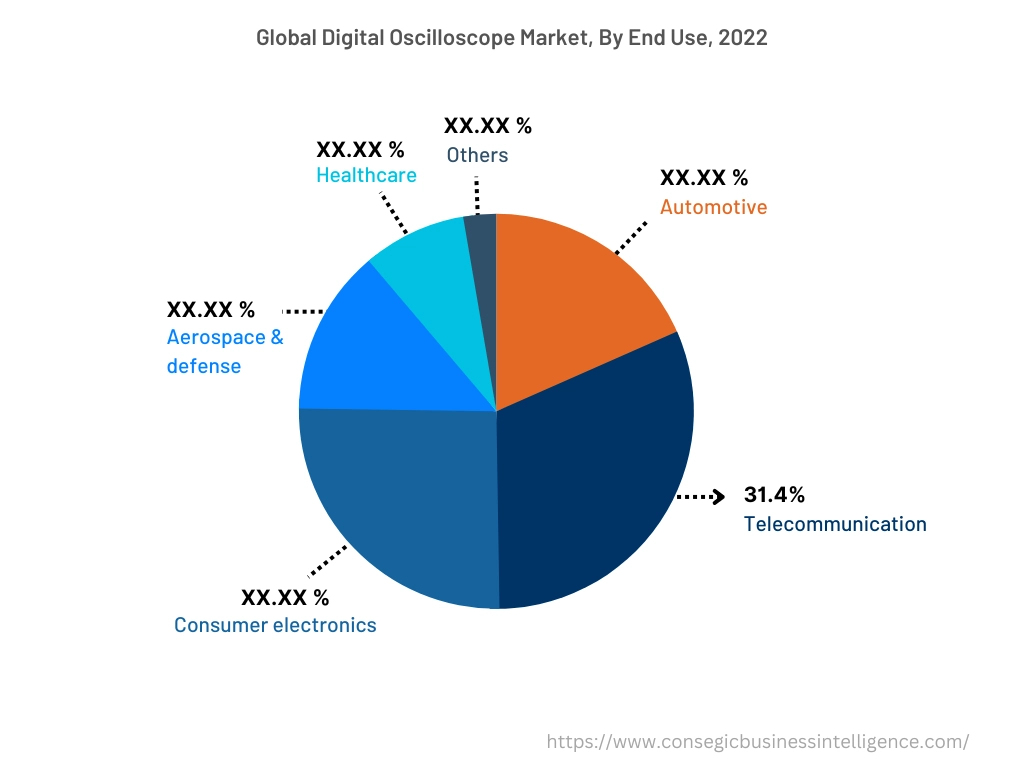
By Region :
The regional segment includes North America, Europe, Asia Pacific, Middle East and Africa, and Latin America.
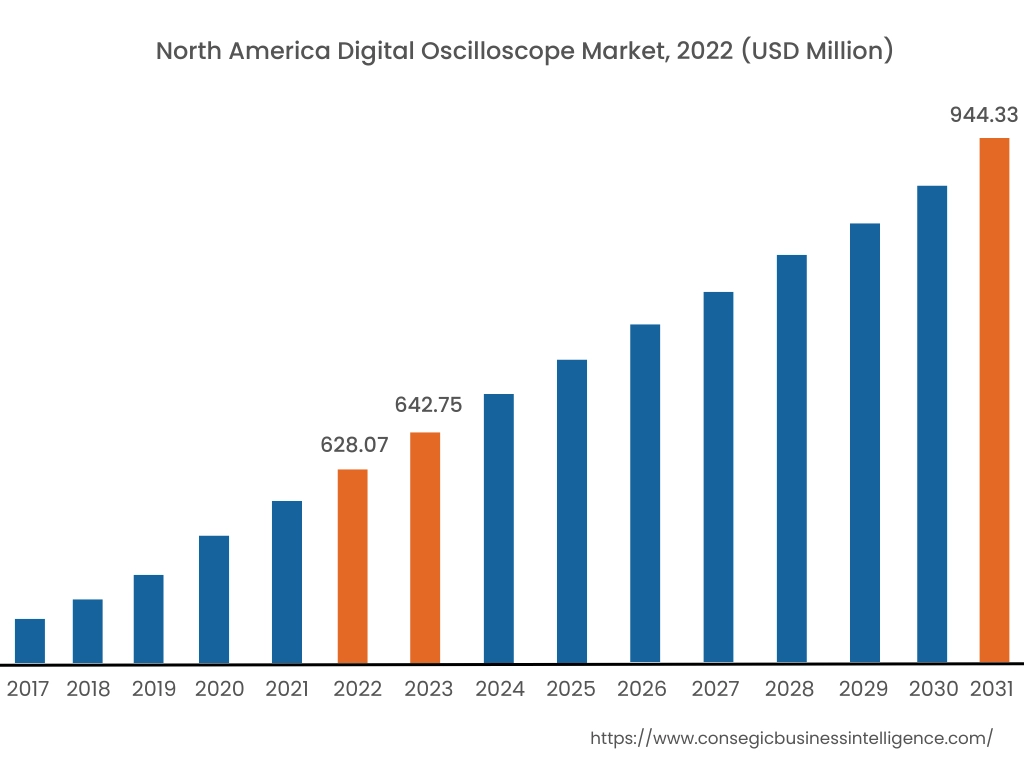
North America accounted for the largest revenue share of USD 628.07 Million in 2022 and is expected to reach USD 944.33 Million by 2031. In addition, in the region, the U.S. accounted for the maximum revenue share of 65.35% in the same year. The adoption of digital oscilloscopes in North America is primarily driven by the high demand for wireless communication systems, along with the presence of key players including Fluke Corporation, Siglent Technologies, Keysight Technologies, among others. Moreover, with the growing requirement for large military and the growth of the automotive sector in the region is driving the market growth for digital oscilloscope.
In addition, North America is considered as one of the major markets for radar systems, which use digital oscilloscopes to transmit and receive radio waves. The increasing demand for radar systems in defense and security applications is driving the demand for digital oscilloscopes. Furthermore, North America is home to a few of the leading digital oscilloscope manufacturers, including Tektronix Inc., Teledyne LeCroy, and Analog Devices. Since, abovementioned companies have a strong research and development (R&D) presence and invest heavily in new technologies, which is helping to drive the growth of the digital oscilloscope market in the region.
Moreover, Asia-Pacific is expected to register the fastest CAGR growth of 5.1% during the forecast period. Factors attributable to the growth of the region during the forecast period are due to strong demand from the automotive sector, rapidly growing communication infrastructure which includes 5G, government initiatives, among others. The automotive sector is a major user of digital oscilloscopes for applications including radar systems, telematics systems, and Bluetooth systems. The increasing demand for connected and autonomous vehicles is driving the demand for digital oscilloscopes in the automotive sector. In addition, Asia-Pacific region is witnessing rapid growth in communication infrastructure, including 5G. Adoption of 5G is thus driving the demand for digital oscilloscopes for testing and troubleshooting communication systems. Also, governments in the Asia-Pacific region are supporting the development of the digital oscilloscope market by investing in research and development and by providing subsidies to manufacturers.
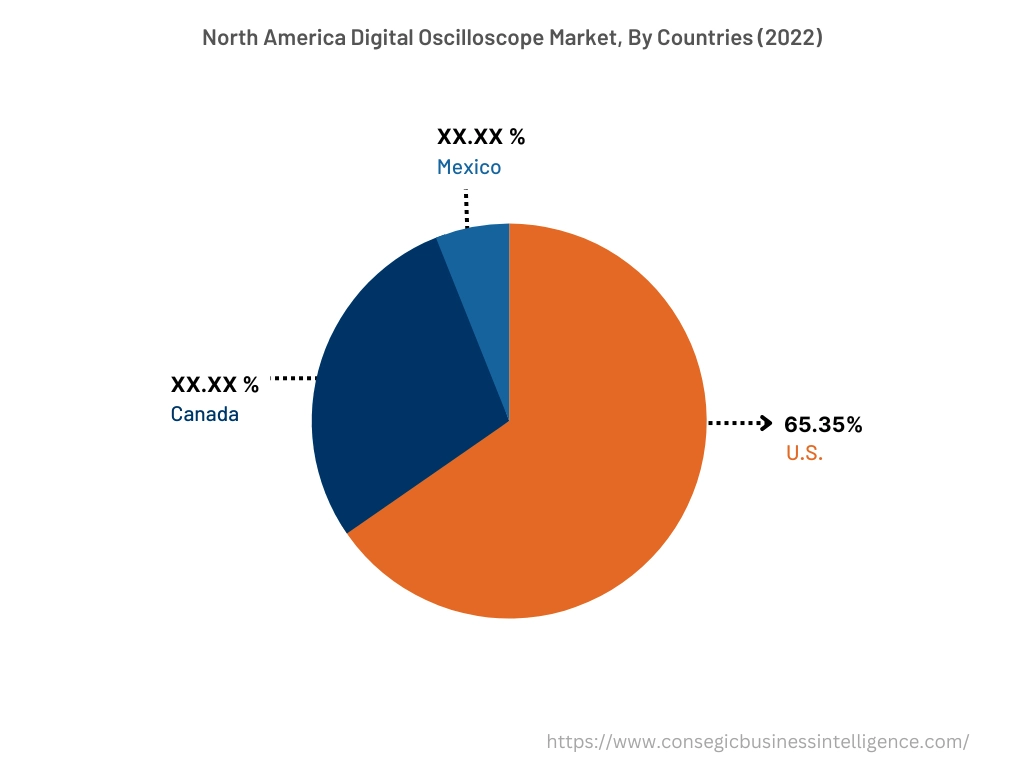
Top Key Players & Market Share Insights:
The Digital Oscilloscope market is highly competitive with major players providing Digital Oscilloscopes to the national and international markets. Key players are adopting several strategies in research and development (R&D), product innovation, and end use launches to hold a strong position in Digital Oscilloscope market. Key players in the Digital Oscilloscope market include-
- OWON Technology Inc.
- Good Will Instrument Co., Ltd.
- Tektronix Inc.
- Teledyne LeCroy
- Olimex
- B&K Precision
- Agilent Technologies Inc.
- Fluke Corporation
- Siglent Technologies
- Keysight Technologies
- Rohde & Schwarz GmbH & Co KG
- Pico Technologies
- Yokogawa Electric Corporation
- General Polytronic Systems Ltd.
Recent Industry Developments :
- In June 2023, Keysight Technologies has launched updated software for Infiniium 9000 Series including 90000 X-Series, S-Series, Z-Series, and V-Series oscilloscopes with the Windows 10 operating system.
- In May 2023, Tektronix, Inc. launched new firmware 6 Series B MSO mixed signal oscilloscope with updated features including TekScope waveform analysis software.
Key Questions Answered in the Report
What is Digital Oscilloscope? +
Digital Oscilloscope is an electronic device that measures and records electronic signals transmitted in the form of analog signals. In another terms, digital oscilloscope transforms analog signals into digital format and stores it in the digital memory format for further analysis.
What specific segmentation details are covered in the digital oscilloscope report, and how is the dominating segment impacting the market growth? +
For instance, by type segment has witnessed digital storage oscilloscopes as the dominating segment in the year 2022, owing to its increasing demand from industries including automotive, telecommunication, and others.
What specific segmentation details are covered in the digital oscilloscope market report, and how is the fastest segment anticipated to impact the market growth? +
For instance, by end use segment has witnessed telecommunication segment to grow at the fastest growth rate during the forecast period. The rising demand for improved devices that are able to communicate more efficiently with other handheld or stationary devices is expected to boost the market growth during the forecast period.
Which region/country is anticipated to witness the highest CAGR during the forecast period, 2023-2031? +
Asia-Pacific is anticipated to register fastest CAGR growth of 5.1% during the forecast period due to rapid pace of industrialization and demand for improved telecommunication infrastructure.
